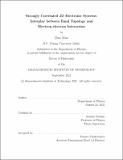Strongly Correlated 2D Electronic Systems: Interplay between Band Topology and Electron-electron Interaction
Author(s)
Mao, Dan
DownloadThesis PDF (4.766Mb)
Advisor
Todadri, Senthil
Terms of use
Metadata
Show full item recordAbstract
In recent years, a new type of 2D materials, moiré superlattice materials, has been made in laboratories and exhibits interesting behavior including superconductivity at “high” temperature, strange metals, correlated insulators, ferromagnetism, etc.[1, 2]
Inspired by these experiments, we studied various graphene-based moiré materials. We found that band topology and electron-electron interaction can be easily tuned by electric field in these systems, which opens the door for various fascinating quantum many-body phenomena such as the quantum Hall effect at zero external magnetic field[3]. Our theoretical prediction was later confirmed by experimental studies[4].
In some moiré materials, the band topology can be tuned between “trivial” and “topologically non-trivial” with a perpendicular displacement field. On the “trivial” side, with electron interaction taken into account, one natural and important question is the low energy effective theory. We constructed an SU(4) Hubbard model for some of these moiré materials, which has been rarely explored in the condensed matter literature. We studied this SU(4) Hubbard model and found that it can realize spin liquids and pseudo-gap metals [5]. On the “topological” side, there is difficulty in formulating a low energy effective lattice model, which comes from an obstruction to constructing symmetric, localized Wannier functions. We circumvented this lattice obstruction by either enlarging the low energy Hilbert space [6] or by constructing a momentum space model[7] for twisted bilayer graphene(TBLG) aligned with hexagonal boron nitride(hBN). We also discussed the effect of translation symmetry breaking in this system[7].
Motivated by these results in moiré superlattices, we considered the effect of electron interaction in a generic topological band. We studied the model of electrons confined to lowest Landau level (LLL) in a spatially periodic magnetic field. We showed that there is a relationship between spatially periodic magnetic field acting on LLL and momentum space periodic Berry curvature in a topological Chern band. We considered spinful electrons at total filling 𝜈 = 1 and studied the spin wave dispersion in the presence of Coulomb potential. We found that compared to uniform magnetic field, the spin stiffness increases in the periodic magnetic field.
Date issued
2021-09Department
Massachusetts Institute of Technology. Department of PhysicsPublisher
Massachusetts Institute of Technology